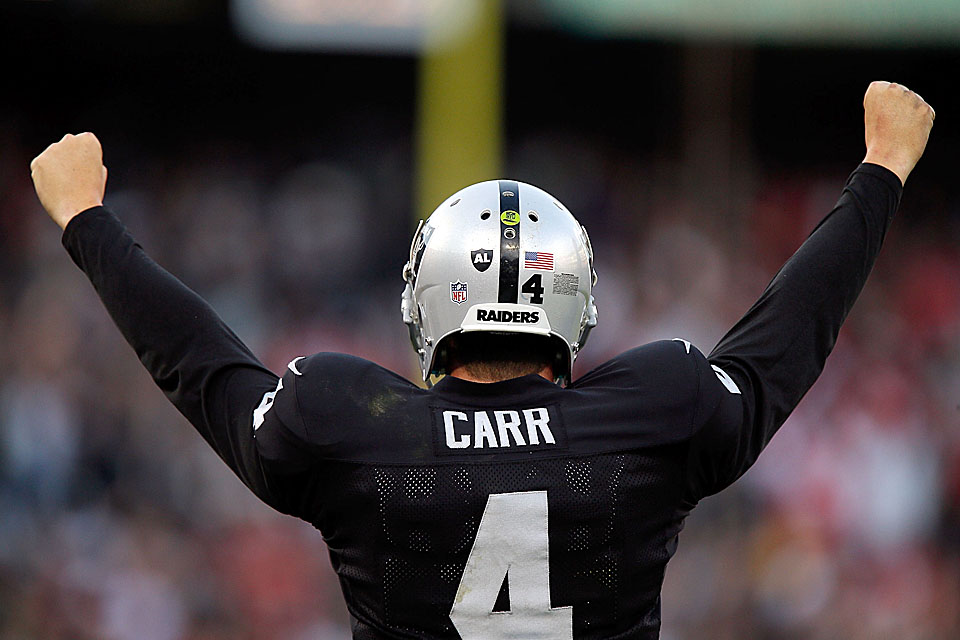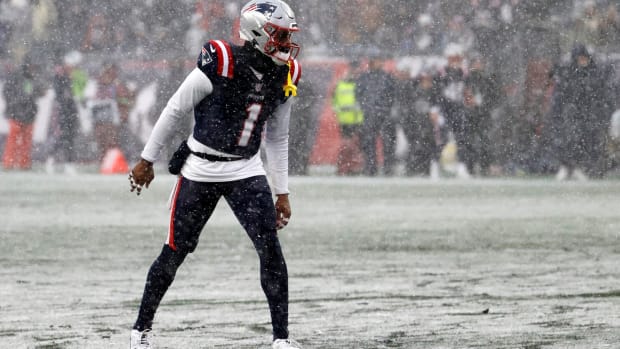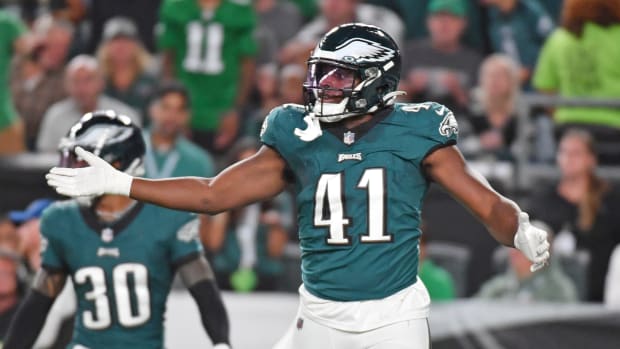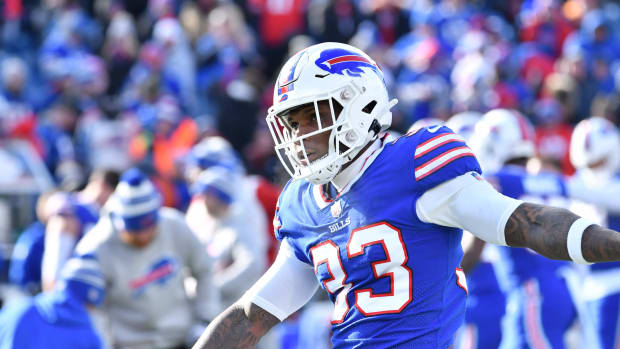
Who Needs Mariota?
Even after last week’s upset over San Francisco, Raiders fans are talking draft and what their team should do with the possible first overall pick. Many have mentioned Marcus Mariota, which would be a foolish move for Oakland to make.
That’s not a commentary on the current Oregon Duck, but rather, on the former Fresno State Bulldog. True, Derek Carr has not set the world on fire, especially given some of the hard lessons he has had to learn from rookie mistakes (see his first interception in the 52-0 loss at St. Louis). But Carr has also shown the foundational skill set of a future franchise quarterback.
Carr makes adjustments at the line of scrimmage. He throws with conviction and velocity, suggesting that unlike a lot of young passers, he trusts what he sees and is willing to anticipate and attack tight windows. His fundamentals are encouraging though, granted, inconsistent. That inconsistency will abate once (O.K., if) he is surrounded by better receivers and a stronger running game.
Currently Carr’s top target is James Jones, a streaky career-long No. 3 receiver. His best vertical weapon is Andre Holmes, who is still learning the nuances of professional football. Tight end Mychal Rivera runs well and has shown flashes as an intermediate pass-catcher, but he isn’t—and might never be—the type of matchup problem defenses adjust game plans for.
Along the offensive line, it’s been a revolving door at right tackle (the perils of choosing between veteran utility man Khalif Barnes and still-unrefined second-year man Menelik Watson). But overall, the pass protection has actually been very solid. In fact, Carr has been sacked just 16 times on 489 drop-backs; only Brady and Manning have a lower percentage among fulltime starters. That said, the front five’s inability to get a consistent push on the ground has contributed to the feebleness of Oakland’s rushing attack.
Despite the limitations around him, Carr has maintained the willingness to play from the pocket. That’s something many coaches—for example, Jay Gruden in Washington—yearn for with young quarterbacks. Carr has a feel for the subtle footwork required to reset and throw when a receiver needs time. Not having had to make throws like these in college, scouts were unsure whether Carr would be able to do that in the NFL. (His brother wasn’t.) Many of Carr’s best throws have come against man coverage, often when aided by specific man-beater route combinations, which Oakland’s wideouts need.
We saw several examples of this in Oakland’s upset of Kansas City, perhaps none better than Carr’s 19-yard completion to Brice Butler:
Through his first 13 games, it’s fair to say that Carr is not the problem in Oakland. In fact, he could be the solution.
Jumping Out on Film
One reason Seattle is soaring and San Francisco is falling: Colin Kaepernick is a QB who can move, while Russell Wilson is a QB who can play on the move. The difference is gargantuan. When Kaepernick moves, it’s one thing at a time: one direction he goes in, one receiver he eyes, one thought he has (usually “run!”). When Wilson moves, multiple things can happen. He shifts in different directions; he’s more apt to scan the field and, physically, he’s ready to throw or run.
He Makes It Look So Easy
We take for granted what Aaron Rodgers is doing this year because it all appears so effortless—time and again he makes the right call, the perfect pass, the smart decision. So let’s take a moment to appreciate a quarterback performing at the absolute pinnacle.
FULL STORY
It’s this last item that defines Wilson’s game. No QB—save for maybe Aaron Rodgers—is better throwing on the move. Going to his right
or
left, Wilson can stretch the field, throw touch passes at all different levels and square up his body to hit moving targets. And he’s the most productive scrambler in the game.
Without Wilson’s skills, Seattle’s offense would cease to exist. The receivers struggle to consistently separate against man coverage, and their route designs, often crafted for widening the field in order to widen Wilson’s lanes, don’t regularly help them out. (You see fewer trips bunches or switch-release and natural rub concepts in this system.)
Wilson does not have receivers like Anquan Boldin or Michael Crabtree who can make contested catches, and his offensive line is not full of Pro Bowlers. But through his movement, Wilson gives Seattle a considerable advantage on plays that go out of structure; defenses, which are designed to combat plays within structure, have a tough time preparing for that.
This advances the increasingly fascinating discussion about what traits comprise a great quarterback. The Mannings and Bradys of the world are great because they make stars out of average players. Wilson, through vastly different means, can do the same thing.
Impressive Coaching
Cowboys passing game coordinator Scott Linehan and running game coordinator Bill Callahan have done a great job taking advantage of the unique mobility and in-space blocking dexterity of center Travis Frederick and right guard Zack Martin. The two coaches have built more screen pass concepts into the offense, including those that feature DeMarco Murray out of the backfield. Opening up the perimeter like this only adds to the punch of what is already the league’s most threatening downhill rushing attack.
Smart Watching for Week 15
Don’t expect Chargers defensive coordinator John Pagano to use as much man coverage as he did against the Patriots and Ravens in recent weeks, even though San Diego’s defensive backs, for the most part, rose to the occasion in press-man against New England. The Broncos, with their litany of crossing routes and “natural rub” concepts, are extremely difficult to defend man-to-man. (The Chargers found this out in Week 8.) Plus, the way to combat Peyton Manning is to change up coverage disguises, something most naturally done through zone.
Eric Weddle will be the key. The most versatile safety in football—and perhaps the smartest—has often been a bother to Manning. Where Weddle lines up before the snap will not be where he winds up after the snap. That’s why you can expect Julius Thomas to make his full return this week. Thomas, who injured his ankle in the Week 11 loss at St. Louis, was active last week against the Bills but did not play. The Broncos stuck with their run-based approach, leaving in blocking tight end Virgil Green or sixth offensive lineman Paul Cornick.
That should change this week. The Chargers secondary has been reshuffled since that Week 8 matchup, but remains a thin unit. By re-inserting Thomas, the Broncos not only challenge that unit but also hinder some of Weddle’s disguises based on how they align their uber-athletic tight end. Expect Thomas to, as usual, detach from the formation often.
Film Room Breakdown
A breakdown of Texans WR DeAndre Hopkins' 58-yard touchdown pass against Tennessee.
Podcast spotlight
We spoke with Bills defensive end Jerry Hughes on last week’s podcast. I pointed out to him that for a defensive player, home crowd noise can be stressful because it impacts his unit’s communication. He agreed, but made a stronger point: home crowd noise is still more stressful to the visiting offense because the offense naturally has more verbiage in its on-field communication. “They might miss a word or two,” Hughes said.
This week we seek similar wisdom from Packers left guard Josh Sitton, who is somehow still one of the most underrated offensive linemen in football.
10 film study quick-hitters
Expect to see a lot of Odell Beckham again on Sunday. (Frederick Breedon/Getty Images)
1. Travis Frederick and Zack Martin aren’t the only first-round center-guard combo that’s soaring. Maurkice Pouncey and David DeCastro have had a lot to do with Le’Veon Bell’s recent success.
2. Look for the Giants to keep getting the ball in Odell Beckham’s hands early in the game. That’s a great way to make a defense reactionary.
3. Don’t be surprised if Darrelle Revis shadows Jarvis Landry instead of Mike Wallace on Sunday. Bill Belichick did not put Aqib Talib on Wallace last year, and Talib style-wise would have matched up well to Wallace. Landry is becoming the better all-around receiver anyway. Revis should take him.
4. Play-action will be big for the Ravens this week against young, hard-flowing Jaguars linebackers Telvin Smith and J.T. Thomas.
5. Did anyone else notice that Buffalo’s vaunted pass rush was irrelevant against Peyton Manning last week? Curious to see if Aaron Rodgers gets the ball out quickly on Sunday.
6. The Browns should consider putting Joe Haden one-on-one against Mohamed Sanu and letting Buster Skrine play A.J. Green underneath with dedicated safety help over the top.
7. The Titans defense has been disappointing this year, but it won’t be this week. Pressure-happy coordinator Ray Horton lives for facing QBs like Geno Smith.
8. The Bears’ reeling secondary will have trouble with the Saints’ “three-level stretch” concepts. (That is, three receivers running post or crossing patterns at the short, intermediate, and deep levels.)
9. Two safeties you could one day build a secondary around are squaring off Thursday night: St. Louis’s T.J. McDonald and Arizona’s Deone Bucannon.
10. A rare bright spot on the 2014 Buccaneers: defensive end Jacquies Smith. He has the edge speed and quickness that Lovie Smith’s scheme demands.
For film study tweets throughout the week, follow @Andy_Benoit
Follow The MMQB on Facebook, Twitter and Instagram.
[widget widget_name="SI Newsletter Widget”]










































